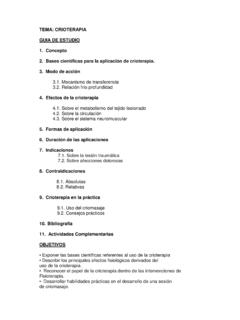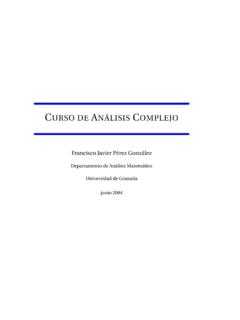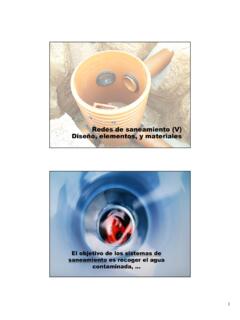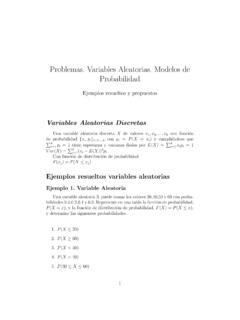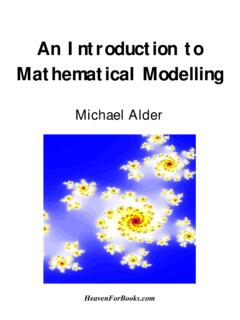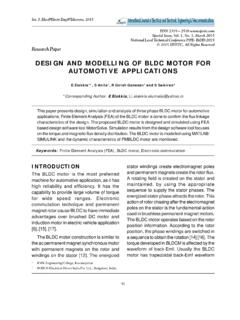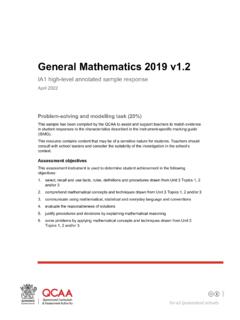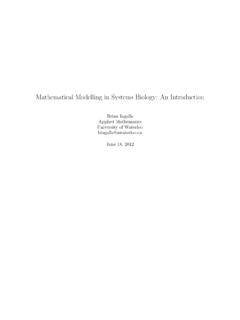Transcription of MATHEMATICAL CONCEPTS, THEIR MEANINGS, AND …
1 MATHEMATICAL CONCEPTS, THEIR MEANINGS, AND UNDERSTANDING1 Juan D. Godino University of Granada (Spain) "Try not to think of understanding as a 'mental process' at For that is the expression which confuses you. (..) In the sense in which there are processess (including mental processes) which are characteristic of understanding, understanding is not a mental process". (Wittgenstein, 1953, Philosophical Investigations, p. 61) Abstract Some key elements for developing a theory for understanding MATHEMATICAL concepts are outlined. These elements are derived from the theory of MATHEMATICAL objects and THEIR meanings developed by Godino and Batanero (1994; 1996).
2 We shall argue for the need to complement the psychological facets of understanding - 'as a mental experience', and 'connection of internal representations in information networks'- with the sociocultural approach, that is, understanding as 'correspondence between personal and institutional meanings'. The role of situation-problems and semiotic instruments is also emphasized in both personal and institutional dimensions of understanding processes. Understanding in Mathematics Education As Hiebert and Carpenter (1992) asserted, one of the most widely accepted ideas in mathematics education is that students should understand mathematics. Sierpinska (1994) starts her book on understanding in mathematics with similar words: "how to teach so that students understand?
3 , What exactly don't they understand? What do they understand and how?" (p. XI). Pirie and Kieren (1994) mention the interest towards teaching and learning mathematics with understanding, which is shown in recent curricular reforms in many countries. This interest is also reflected in conference proceedings and research articles in psychology and artificial intelligence. The importance of the idea of understanding for mathematics education is emphasized in recent works by Sierpinska, Pirie and Kieren, Koyama (1993), amongst others. Nevertheless, characterizing understanding "in a way which highlights its growth, and identifying pedagogical acts which sponsor it, however, represent continuing problems" (Pirie and Kieren, 1994, p.)
4 165). The use of the term 'understanding' (or 'comprehension') is varied, depending on institutional contexts, although the dominant psychological approach emphasizes the mental facet of understanding, which is strongly challenged by Wittgenstein. The cognitive revolution supported by Vygotsky -who claims the analytical and genetic priority of sociocultural factors when attempt to understand individual psychological 1 In L. Puig y A. Gutierrez (Eds.), Proceedings of XX Conference of the International Group for the Psychology of Mathematics Education. ( , pp. 417-425). Universidad de Valencia. 1processes-, Bruner (1990) -with his proposal of a cultural psychology, or Chevallard (1992) -who speaks of cognitive and didactical anthropology- requires a reconceptualization of MATHEMATICAL knowledge and its understanding.
5 The book by Sierpinska (1994) represents an important step forward, when discerning between understanding acts and processes and when relating "good understanding" of a MATHEMATICAL situation ( concept , theory, problem) to the sequence of acts of overcoming obstacles specific to this situation. Through the historico-empirical approach it is possible to identify meaningful acts for understanding a concept . Nevertheless, we think that taking the notion of object as primitive and deriving meaning from understanding cause some difficulties in analyzing the processes of assessing students' understanding. From our point of view, a theory of conceptual understanding useful for mathematics education should not be limited to saying, for example, that understanding the concept of function is a person's mental experience assigning some object to the term 'function'.
6 A cultural entity, a very complex, not ostensive object is designated with the term 'function'. Therefore, in order to define what is understanding the concept of function, we need to clarify a previous question: What object must the student assign to the term 'function' so that the teacher may say that he/she understands the object function? The problem of understanding is, consequently, closely linked to how the nature of MATHEMATICAL knowledge is conceived. MATHEMATICAL terms and expressions denote abstract entities whose nature and origin should be researched for elaborating a useful and effective theory for what it is to understand such objects. This research requires answering questions such as: What is the structure of the object to be understood?
7 What forms or ways of understanding exist for each concept ? What are the possible and desirable aspects or components of MATHEMATICAL concepts for students to learn at a given time and under certain circumstances? How are these components developed? If, for example, we consider MATHEMATICAL knowledge as internally represented information, understanding occurs when the representations achieved are connected by progressively more structured and cohesive networks (Hiebert and Carpenter, 1992). However, we consider it excessively reduccionist to view MATHEMATICAL activity as information processing . From our point of view, the theories of understanding derived from this conception do not adequately describe the teaching and learning processes of mathematics, especially the social and cultural aspects involved in theses processes.
8 We think that a theory of understanding MATHEMATICAL abstractions must be supported by a previous theory concerning the nature of such objects. In this research report, we first present a summary of our previous theoretical articles on the nature of the MATHEMATICAL objects and its meanings (Godino and Batanero 1994; 1996). After this synthesis, we shall provide some elements deduced from this theory, to be taken into account for the development of a theory of understanding in the teaching and learning of mathematics. Pragmatic and relativist ontosemantics for mathematics Our theory is based on the following epistemological and cognitive assumptions about mathematics, which take into account some recent tendencies in the philosophy of mathematics (Tymoczko, 1986, Ernest, 1991): 2a) Mathematics is a human activity involving the solution of problematic situations.
9 In finding the responses or solutions to these external and internal problems, MATHEMATICAL objects progressively emerge and evolve. According to Piagetian constructivist theories, people's acts must be considered the genetic source of MATHEMATICAL conceptualization. b) MATHEMATICAL problems and THEIR solutions are shared in specific institutions or collectives involved in studying such problems. Thus, MATHEMATICAL objects are socially shared cultural entities. c) Mathematics is a symbolic language in which problem-situations and the solutions found are expressed. The systems of MATHEMATICAL symbols have a communicative function and an instrumental role. d) Mathematics is a logically organized conceptual system.
10 Once a MATHEMATICAL object has been accepted as a part of this system, it can also be considered as a textual reality and a component of the global structure. It may be handled as a whole to create new MATHEMATICAL objects, widening the range of MATHEMATICAL tools and, at the same time, introducing new restrictions in MATHEMATICAL work and language. To build our model, we take the notion of problem-situation as a primitive idea. Problems do not appear in isolation; the systematic variation of the variables intervening in problem-situations yields different fields of problems, sharing similar representations, solutions, etc. The subject performs different types of practices, or actions intended to solve a MATHEMATICAL problem, to communicate the solution to other people or to validate or generalize that solution to other settings and problems.
